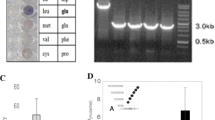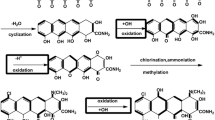Abstract
A recombinant strain of S. clavuligerus (LHM100) that contains an additional copy of the gene (lat) encoding lysine ε-aminotransferase (LAT) was analyzed and compared to the wild-type for intracellular concentrations of primary metabolites involved in cephamycin C biosynthesis. This strain had been shown previously to produce higher levels of the antibiotic because of increased levels of LAT, a rate-limiting enzyme involved in the production of α-amino-adipic acid. The results showed that the overall growth kinetics of the two strains were comparable, including the intracellular concentrations of cysteine, valine and lysine. In contrast, 60% higher antibiotic production was observed in LHM100, which reflected a significant temporal variation in specific metabolite production rate. The time profile of LAT activity was consistently higher in LHM100; however, α-aminoadipic acid levels showed unexpected variation during the growth cycle. These results support the proposal that rate-limiting enzymes in cephamycin C biosynthesis are temporally controlled, and indicate that optimization of metabolite production will require differential overexpression of several biosynthetic genes.
Similar content being viewed by others
References
Aharonowitz Y, Demain AL (1979) Nitrogen nutrition and regulation of cephalosporin production in Streptomyces clavuligerus. Can J Microbiol 25:61–67
Bradford MM (1976) A rapid and sensitive method for the quantitation of microgram quantities of protein utilizing the principle of protein-dye binding. Anal Biochem 72:248–252
Brana AF, Paiva N, Demain AL (1986) Pathway and regulation of ammonium assimilation of Streptomyces clavuligerus. J Gen Microbiol 132:1305–1317
Demain AL (1992) Secondary metabolites: their function and evolution. In: Ciba Found Symp 171:3–23
Heinrich R, Rapoport TA (1974) Metabolic regulation. Eur J Biochem 42:97–105
Jose J, Coque R, Liras P, Martin JF (1993) Genes for a \-lactamase, a penicillin-binding protein and a transmembrane protein are clustered with the cephamycin biosynthetic genes in Nocardia lactamdurans. EMBO J 12:631–639
Kacser H, Burns JA (1973) Rate control of biological processes. In: Davies DD (ed) Rate control of biological processes. Cambridge University Press, Cambridge, pp 65–104
Kern BA, Hendlin D, Inamine E (1980) L-Lysine ε-aminotransferase involved in cephamycin C synthesis in Streptomyces lactamdurans. Antimicrob Agents Chemother 17:679–685
Madduri K, Stuttard C, Vining LC (1989) Lysine catabolism in Streptomyces spp. is primarily through cadaverine: \-lactam producers also make α-aminoadipate. J Bacteriol 171:299–302
Madduri K, Shapiro S, DeMarco AC, White RL, Stuttard C, Vining LC (1991) Lysine catabolism and α-aminoadipate synthesis in Streptomyces clavuligerus. Appl Microbiol Biotechnol 35:358–363
Malmberg L-H, Hu W-S (1991) Kinetic analysis of cephalosporin biosynthesis in Streptomyces clavuligerus. Biotechnol Bioeng 38:941–947
Malmberg L-H, Hu W-S (1992) Identification of rate-limiting steps in cephalosporin C biosynthesis in Cephalosporium acremonium: a theoretical analysis. Appl Microbiol Biotechnol 38:122–128
Malmberg L-H, Hu WS, Sherman DH (1993) Precursor flux control through targeted chromosomal insertion of the lysine ε-aminotransferase (lat) gene in cephamycin C biosynthesis. J Bacteriol 175:6916–6924
Newton GL, Fahey RC, Cohen G, Aharonowitz Y (1993) Low-molecular-weight thiols in streptomycetes and their potential role as antioxidants. J Bacteriol 175:2734–2742
Skatrud PL, Tietz AJ, Ingolia TD, Cantwell CA, Fisher DL, Chapman JL, Queener SW (1989) Use of recombinant DNA to improve production of cephalosporin C by Cephalosporium acremonium. Biotechnology 7:477–485
Zhang J, Wolfe S, Demain AL (1989) Phosphate regulation of ACV synthetase and cephalosporin biosynthesis in Streptomyces clavuligerus. FEMS Microbiol Lett 48:145–150
Author information
Authors and Affiliations
Rights and permissions
About this article
Cite this article
Malmberg, L.H., Hu, W.S. & Sherman, D.H. Effects of enhanced lysine ε-aminotransferase activity on cephamycin biosynthesis in Streptomyces clavuligerus . Appl Microbiol Biotechnol 44, 198–205 (1995). https://doi.org/10.1007/BF00164502
Received:
Revised:
Accepted:
Issue Date:
DOI: https://doi.org/10.1007/BF00164502




